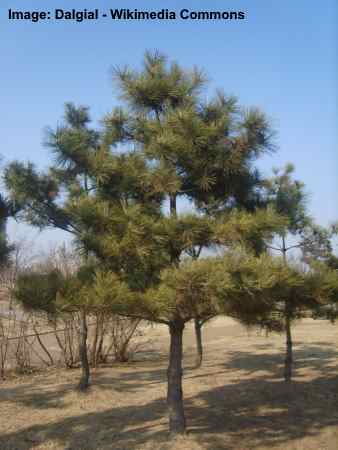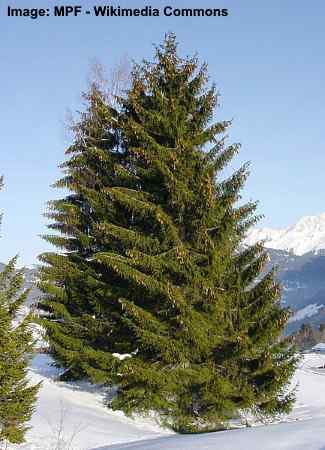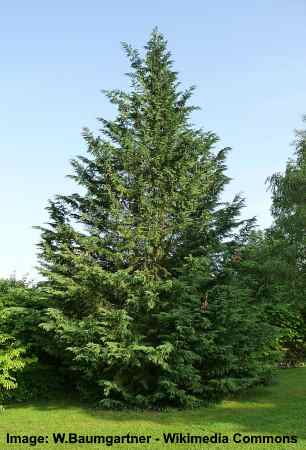Types of Evergreen Trees with Identification Guide, Pictures and Names

Evergreen trees are the perfect type of tree to landscape a garden or backyard. Types of trees such as pines, firs, spruces, and cedars only lose their leaves gradually and they stay green all year long. Some species of evergreen trees are large elegant trees and some are small bushy shrubs. So, whatever your landscaping needs are, there are many varieties of evergreen trees to choose from.
Evergreen trees are hardy woody plants that endure a wide range of climates. Before choosing an evergreen for your landscape, you should pay attention to growing zones and cold hardiness. Some evergreen trees and shrubs are great for privacy hedges, some make beautiful ornamental trees, and others provide shade or ground cover.
Although there are types of broad-leafed trees that are evergreen, this article looks at types of conifers or needle evergreens. As well as their botanical name, you will find descriptions and pictures to help identify the best conifers for your landscape garden.
What are Evergreen Trees?
Species of evergreen trees are ones that stay green throughout all the seasons. Even in cold freezing conditions or hot arid climates, evergreen trees are always in varying shades of green.
Conifers have leaves that are needle-like. Depending on the species, these can be soft, such as those on fir or cypress trees, or the needles on some pine trees and junipers can be sharp and spiky. However, many species of pine trees and spruce trees have soft needle leaves.
Most types of evergreen trees produce cones. There are two types – pollen cones and seed cones.
Evergreen Trees for Landscaping
Before choosing evergreen trees to landscape your garden, it is important to choose the right ones.
Some species of cypress and conifer trees are fast-growing and are perfect for creating screening hedges or windbreaks.
Many types of firs, spruces, and pines grow at a slower rate and have a conical shape that looks like a Christmas tree. You can also create a dramatic effect in your landscape by planting weeping evergreens or ones that can be pruned and shaped.
Depending on your landscape requirements, you can also choose dwarf evergreen trees. These evergreens don’t grow too tall. In fact, they may only grow to around 3 to 6 ft. (1 – 2 m) high and don’t reach the huge heights that some pines and firs grow to.
Evergreen Tree Identification
It is often possible to identify the difference between the different types of evergreens such as firs, pines, and spruces by their needles and cones.
For example, needles on pine trees grow in clusters of 2, 3, 4, or 5 on the twigs, whereas spruce and firs are attached singularly. Fir trees tend to have flat needles, unlike pines and spruces.
To tell the difference by looking at cones growing on the tree, fir tree cones stand erect on the branches but spruce and pine cones droop down.
Types of Evergreen Trees – Pine
Let’s look in more detail at some of the most popular types of evergreen trees for your garden or backyard.
Eastern White Pine Tree (Pinus strobus)
Also called the soft pine, this type of pine tree is fast-growing and is a beautiful ornamental evergreen tree for gardens and landscaping. With proper pruning, you can also use eastern white pines as a privacy hedge if you plant a few together.
Evergreen Tree Identification
These pines grow to 230 ft. (70 m) but dwarf varieties reach heights of between 3 and 5 ft. (0.9 – 1.5 m). Eastern white pines have bluish-green needles, slender light brown cones, and evenly spaced branches.
Scots Pine (Pinus sylvestris)
The Scots pine tree is an attractive type of evergreen conifer for landscaping. Some dwarf tree varieties such as the ‘Glauca’ are specially adapted for small gardens. They tend to have a mass of flat foliage at the top of the tree that looks like an umbrella. These grow well in containers and are a popular type of Christmas tree.
Evergreen Tree Identification
Scots pines are slow-growing landscape trees that grow to 114 ft. (35 m) and have attractive blue-green foliage that becomes silvery-blue in the winter. Cones are red that turn to brown as they mature.
Norway Pine (Pinus resinosa)
Also called the red pine, some species of Norway pine have drooping branches that give this evergreen tree a weeping look. Other types of landscaping Norway pine have a conical shape and with upturned branches. These are cold hardy pine trees that grow well in full sun and acidic soil.
Evergreen Tree Identification
Large specimens can grow to between 66 and 115 ft. (30 – 60 m) and have dark green sharp needles, egg-shaped brown cones, and flaky bark that is orange-red towards the top of the tree.
Pinyon Pine (Pinus Cembroides)
Pinyon pine trees are well-suited evergreens for landscaping as they are slow-growing and can create shrub borders or specimen trees. These hardy pine trees survive well in warm climates and can survive periods of drought. Pinyon pines are also good trees to grow if you want to harvest their edible pine nuts from the cones.
Evergreen Tree Identification
These small pine trees have a wonderful pyramid shape and they grow to 20 ft. (6 m) tall. Their upturned branches, yellow-green long needles, and small cones make this an attractive species for a landscaped garden.
Japanese Black Pine (Pinus thunbergii)
The wide-spreading nature of its foliage and crooked branches of the Japanese black pine gives this evergreen landscape tree an exotic oriental look. This Asian pine species is good for pruning to create beautiful decorative pine trees. It is also a perfect tree to create miniature trees and bonsai trees.
Evergreen Tree Identification
The Japanese black pine foliage is light silvery-green, has needles that are up to 5” (12 cm) long, and small cones that grow in clusters. As its common name suggests, these pine trees are identified by their unique black bark.
Douglas Fir Tree (Pseudotsuga menziesii)
Although called a fir tree, the Douglas fir belongs to the family of evergreen pine trees. These evergreen conifers have soft flat needle-like leaves. The conical shape of the tree gives it an important ornamental value that adds year-long greenery to garden landscapes.
Evergreen Tree Identification
Douglas firs grow to between 70 and 260 ft. (20 – 80 m) tall. They have needles that are 1.5” (4 cm) long that are attached singularly and completely cover light brown branches. Large tan-colored scaly cones droop down from the branches.
Types of Evergreen Trees – Spruce
Norway Spruce (Picea abies)
Norway spruces have a distinct pyramidal shape with soft green needles that have blunted tips. These are fast-growing conifers that can be used in landscaping to create large privacy hedges or a singular specimen tree. Norway spruces are suitable for colder environments and they are popular Christmas trees.
Evergreen Tree Identification
Norway spruce trees grow to between 115 and 180 ft. (35 – 55 m) tall. They have large cones that are 7” (18 cm) long, short soft needles, and branches that form a triangular cone shape.
White Spruce (Picea glauca)
Also called the Alberta spruce, this fast-growing coniferous evergreen tree has a distinctly conical shape. Some mature varieties look like skinny conifers with slightly drooping branches. Dwarf landscaping cultivars have a conical shape and their light-green soft needles give the tree a “fuzzy” appearance. These are perfect for foundation plantings, hedges, or as a specimen plant.
Evergreen Tree Identification
As a landscaping tree, the dwarf white spruce ‘Conica’ grows to 13 ft. (4 m) and has a spread of 10 ft. (3 m) at its widest part.
Colorado Blue Spruce (Picea pungens)
The pyramidal shapes of the Colorado blue spruce, its blue-green foliage, and sharp spiky branches make this a great addition to the garden landscape. This ornamental tree grows well in most zones and enjoys plenty of sun. Looking at pictures of this spruce specimen, you can recognize it by the distinct blue color of the leaves and foliage.
Evergreen Tree Identification
Colorado blue spruce trees grow up to 49 ft. (15 m) tall. The evergreens have waxy bluish needles measuring 1” (2.5 cm) that grow radially on the branches that curve upwards. The pale brown 4-inch (10-cm) long cones contrast well with the silvery-blue foliage.
Types of Evergreen Trees – Fir
White Fir Tree (Abies concolor)
From all species of evergreen fir trees, the white fir tree is one of the popular landscaping choices due to its ornamental value. The light blue-green foliage creates a beautiful contrast with darker colored firs or spruces. This hardy fir tree grows as well in hot climates as it does in cooler ones.
Evergreen Tree Identification
Prized for its beautiful winter-green foliage, the white fir tree grows to between 50 and 75 ft. (15 – 22 m). It has 3” (7.6 cm) long light-colored needles, 5” (13 cm) long brown cones, and white bark.
Related: Types of Spruce Trees
Fraser Fir (Abies fraseri)
Fraser firs are great additions to ornamental gardens due to their soft green needles, narrow pyramid shape, and low maintenance. These firs grow well in cooler climates and are a great choice if you need a vertical accent in your landscape. They also make for good specimen trees, border plantings, or container plants on a patio.
Evergreen Tree Identification
Fraser firs have a classic Christmas tree shape, grow to between 30 and 50 ft. (10 – 15 m), have soft dark green needle leaves, and 2.75” (7 cm) cones that grow erect on branches.
Types of Evergreen Tree – Cypress
Mediterranean Cypress Evergreen Tree (Cupressus sempervirens)
Mediterranean cypress trees are tall slender evergreen trees that add height, elegance, and beauty to any ornamental garden landscape. These narrow columnar trees have dark dense soft foliage and are excellent for creating stunning large hedges.
Evergreen Tree Identification
Mediterranean cypress conifers have a slender pointed shape and grow up to 115 ft. (35 m) tall. These tall skinny trees feature soft dark green or silvery-blue needles, small oval brown cones, and give off a pleasant scent.
Leyland Cypress Tree (Cupressus × leylandii)
One of the most popular landscaping conifers is the Leyland cypress due to its fast growth, thick green foliage, and soft feathery touch. These are excellent additions to landscaped backyards to create privacy hedges, soft borders, or just as a decorative tree. Leyland cypresses can grow around 3 ft. (1 m) per year.
Evergreen Tree Identification
These cypress trees grow to between 65 and 82 ft. (20 – 25 m) and are identified by their flat soft scaly needles and small cones measuring 0.78” (2 cm).
Thuja Emerald Green (Thuja occidentalis)

Thuja Emerald Green is a common evergreen tree in many gardens. It’s also one of the best trees for privacy.
Thujas are shrub-like evergreen trees in the cypress family (Cupressaceae) that are well-known for their soft nature, lime green color, and conical shape. The ‘Emerald Green’ thuja is a dwarf variety that doesn’t grow too tall. It is perfect for creating borders, hedges, and screenings in a landscape. For the adventurous gardener, thujas are easy to shape into ornate forms.
Evergreen Tree Identification
This evergreen dwarf cypress species grows to between 12 and 14 ft. (3.6 – 4.2 m) and has a spread of up to 4 ft. (1.2 m). Its feathery emerald green foliage, aromatic qualities, and slender conical shape make these popular landscape trees.
Thuja Green Giant (Thuja plicata ‘Green Giant’)
The ‘Green Giant’ thuja cultivar is an evergreen hybrid of the Thuja standishii and Thuja plicata species. This species of thuja is excellent tree for creating tall privacy hedges or windbreaks. They complement other trees in a landscaped garden with their glossy green foliage, pyramidal growth habit, and low maintenance. Many gardeners choose ‘Green Giants’ in place of Leyland cypress as they are more resistant to disease.
Evergreen Tree Identification
Growing up to 40 ft. (18 m), a thuja ‘Green Giant’ can create a majestic statement in a landscaped backyard. It has soft dark green needles on branches that grow to form a conical evergreen.
Arizona Cypress (Cupressus arizonica)
Another favorite for landscaped areas is the Arizona cypress. This is a popular evergreen conifer because it has a conical shape, soft dense green foliage, and high ornamental value. Some species of Arizona cypress have dull blue-green scaly needle-like leaves and others are gray-green in color. To really make a statement with a spectacular landscape tree, choose the ‘Blue Ice’ cypress. This has a narrow columnar nature, oblong cones, and is drought and heat tolerant.
Evergreen Tree Identification
Arizona cypress trees grow to between 40 and 50 ft. (12 – 15 m) tall. However, pruning and shearing can control growth and help to form attractive soft hedges. Needles are green and flat with scales and measure up to 0.2” (0.5 cm) long.
Types of Evergreen Trees – Cedar and Juniper
Chinese Juniper Tree (Juniperus chinensis)
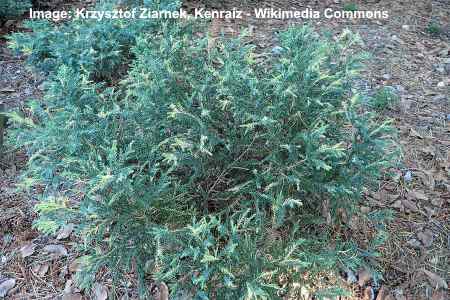
Chinese Juniper includes many cultivars. In the picture is Juniperus chinensis ‘Expansa Aureospicata’
The Chinese juniper is a decorative evergreen shrubby tree that has needle-like leaves and also scale-leaves. This species of juniper is a popular choice for landscape parks, gardens, and green areas. There are also hundreds of Chinese juniper cultivars that are adapted to growing in a wide range of climates. Some evergreens have dark green spiky foliage, others have yellowish-green leaves, and some species have blue-green foliage.
Evergreen Tree Identification
Depending on the cultivar, Chinese junipers grow to between 3 and 65 ft. (1 – 20 m). Needle leaves are short and only 0.4” (1 cm) long and the tree produces small dark blue or black berry-like cones.
Hollywood Juniper Evergreen Tree (Juniperus chinensis ‘Torulosa’)
The Hollywood Juniper is a spectacular landscape specimen tree with dark green-bluish foliage, twisting branches, and fast-growing nature. The common name of this beautiful juniper evergreen comes from its popularity in Los Angeles gardens. The specimen tree can be pruned and shaped or you can create a stunning privacy screen or windbreak. This cultivar grows in most zones apart from very cold climates.
Evergreen Tree Identification
The Hollywood juniper grows up to 15 ft. (4.5 m) tall, it has lush green foliage that is dense and strong.
Eastern Red Cedar (Juniperus virginiana)
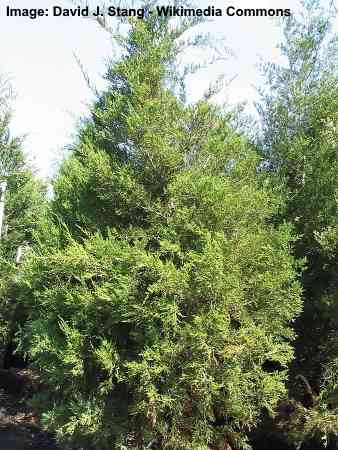
The Eastern Red Cedar is a slow growing hardy evergreen tree. It is not one of the true types of cedar trees.
The Eastern red cedar is also a species of ornamental evergreen juniper tree that is hardy and drought-resistant. These are slow-growing woody plants that have a bushy conical shape and dense, dark green foliage. The trees can grow tall where they take on a slenderer, pointed shape.
Evergreen Tree Identification
Easter red cedars grow to between 16 to 66 ft. (5 – 20 m). The species is identified by sharp needle-like leaves and flattened scale-like leaves. These can be up to 0.4” (1 cm) and cover the brown woody branches. As with most evergreen junipers, this the eastern red cedar has small black berry-like cones.
Types of Evergreen Trees – Yew Trees
Yew trees are a group of coniferous evergreen trees with dark-green linear needle-like leaves, small red berry-like fruits, and small inconspicuous flowers.
The English yew (Taxus baccata) is the most common species of yew trees. But Irish yew, Western yew, and Japanese yew are also ornamental conifer trees.
Common Yew / English Yew (Taxus baccata)

Common Yew / English Yew (Taxus baccata)
The English Yew or Common Yew is a medium-sized evergreen tree with flat needle leaves and red fruits growing around a single seed. The common yew grows between 30 and 60 ft. (9 – 18 m) tall and 15 to 25 ft. (4.5 – 7.6 m) wide.
The English yew fruits are small fleshy, cup-shaped structures with a seed in the center. The red or burgundy berry-like arils measure up to 1” (2.5 cm) and appear on the tree in the fall. The flesh of the red yew fruits is the only part of the tree that isn’t poisonous. The berry-like fruits have a sweet taste.
Evergreen tree identification
The evergreen English yew tree can be identified by its flat leaves, thin scaly brown bark, and fleshy red cup-shaped berries.
Related articles:






